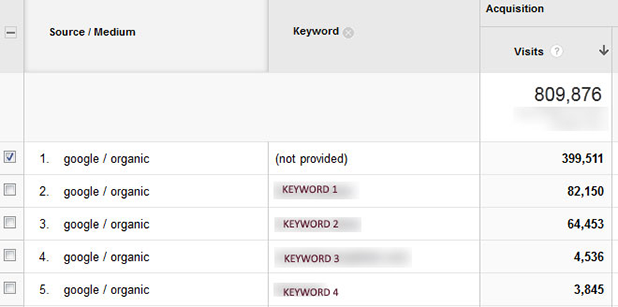Google Analytics: The Dreaded "(not provided)" and How To Get Around the New Changes

Look at the graph above. See that orange line that starts somewhere near 5-10% of the total traffic and grows to almost 100% as of today? If you’re a marketer, this is a VERY important thing to take note of.
Google has openly come out to say that they are obfuscating and encrypting data coming from organic Google searches. They are hiding the keywords that are driving traffic to your site, and it’s hurting your ability to make good decisions around content creation.
What do I mean? Well, if we look at the following table, which I generated inside Google Analytics. It appeared under the graph above:

You can see in this example, 399,511 out of 809,876 visits to the site from Google are being listed without a provided keyword. With this data, we have no idea what keyword drove that traffic! As a marketer, the rise of the (not provided) data makes us sweat a little bit.
Create the graph yourself by going to:
- Log into your Google Analytics account
- Find your profile, then along the left side of the screen, click “Acquisition” (formally “Traffic Sources”)
- Click “All Traffic”
- In the window to the right, find and click “google / organic”
- In the box that says “Secondary Dimension”, type in “Keyword”. This will show you the keywords that drove traffic organically through Google
- Find “(not provided)” and check the box to the left
- Above the checked box, click “Plot Rows”
- Finally, change the date range in the top right corner to the last 12 or 18 months
The reason Google did this isn’t totally clear, but they are claiming it’s for the benefit of their searchers. In 2011, Google started encrypting all data for logged in users (logged into Google when you search). That encrypted data was possibly 10-15% of all Google organic data, which was indicative in the top graph at the far left. As a marketer, that wasn’t so bad; you were able to see all search queries, unless the person was logged in.
Then, Google started encrypting all searches inside Chrome’s “Omnibox”, the search-and-URL bar on their browser. This increased the traffic whose sources were being encrypted and not recorded correctly by Google Analytics.
Just recently, Google made a big move to encrypt ALL data, including the searches of those who are not signed in. Why? That’s a good question. Maybe it’s a post-PRISM encryption so they can still comply with NSA and PRISM requests, but not provide complete data? Maybe they wanted to take a stance for encrypted data and reduce tracking online?
Heck, I just got a new computer and when I was setting it up, it asked me “Send a Do Not Track request to websites you visit in Internet Explorer”; and it was already turned on! Mozilla, the company behind Firefox, stated they’d run with a Do Not Track setting turned on, further complicating and obfuscating the data for marketers.
There would be reason to be upset, if not for the workaround I’m about to show you. You see, Google may have hidden this data from Google Analytics, but they didn’t hide it in Google Webmaster Tools. If you haven’t used Webmaster Tools before, simply go to https://www.google.com/webmasters/tools/home?hl=en and link your domain. From there, you’ll be able to see the last 30 days worth of search queries, impressions, clicks, and average position on Google’s search results page.

The catch here is looking at that data monthly, to see where your traffic is coming from. If you want to earn yourself a few extra Marketing Nerd points, you could even set yourself a calendar reminder every month to download that data, since it overwrites itself daily.
What percentage of your sites traffic has been obfuscated? Do you think you’ll take the time to check Webmaster Tools regularly to keep up on new traffic trends? Let me know in the comment section.
